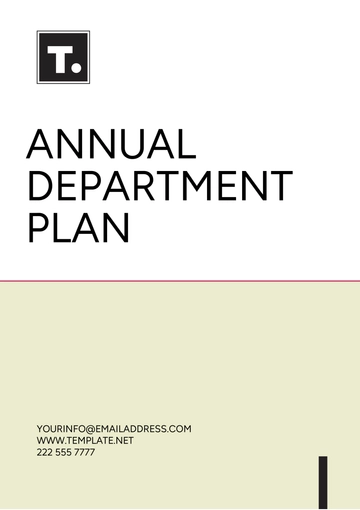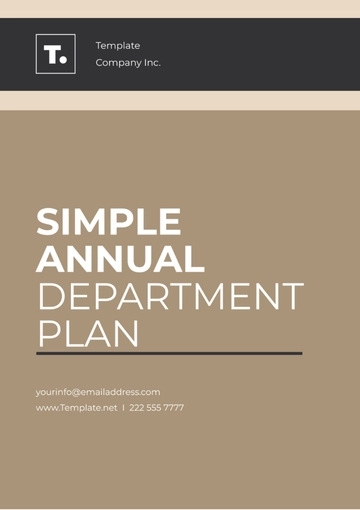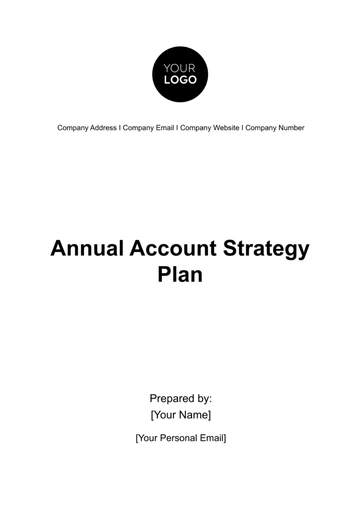Free Annual Account Strategy Plan
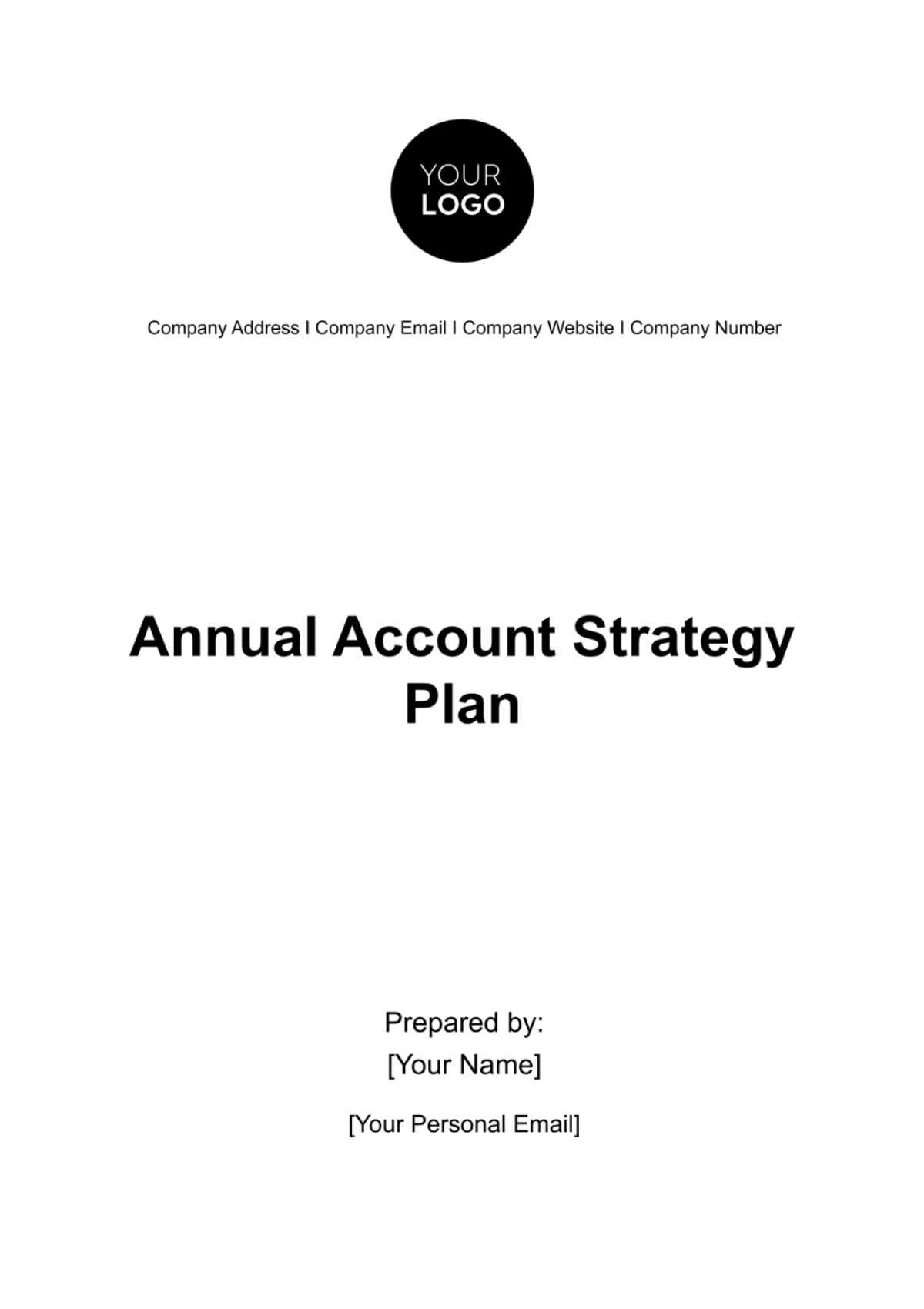
Executive Overview
The Annual Account Strategy Plan is a strategic blueprint designed to guide our organization through the upcoming fiscal year, focusing on maximizing client relationships and profitability. This comprehensive plan is crafted to address the multifaceted aspects of account management, customer engagement, and market positioning.
Goals and Strategies:
Client Acquisition and Retention: Amplify our customer base by 15% while maintaining a 90% retention rate. This will be achieved through targeted marketing campaigns, enhanced customer service initiatives, and loyalty programs.
Profitability Enhancement: Boost overall account profitability by 20% through strategic upselling and cross-selling, optimization of pricing strategies, and cost-effective service delivery.
Market Positioning: Solidify our position as a market leader by adopting innovative solutions, staying ahead of industry trends, and outmaneuvering competitors.
Objectives
The main primary objectives of this Plan include acquiring new clients, retaining existing clients, identifying cross-selling and upselling opportunities, and increasing the overall account profitability. These goals promote business growth and stability by fostering a long-term and vibrant client-business relationship.
Client Acquisition
Target New Markets: Expand into two new market segments, focusing on untapped customer demographics.
Enhanced Digital Presence: Increase online marketing efforts by 30%, utilizing SEO, social media, and targeted advertising.
Referral Programs: Launch a client referral program, aiming for a 10% client acquisition rate through this channel.
Client Retention
Customer Satisfaction: Achieve a 95% customer satisfaction rate through improved service delivery and support.
Feedback Mechanisms: Implement monthly customer feedback surveys to identify areas for improvement and act on them promptly.
Loyalty Incentives: Develop a tiered loyalty program, offering exclusive benefits to long-standing clients.
Profitability Increases
Cost Management: Reduce operational costs by 10% through process optimization and technology integration.
Upselling/Cross-Selling: Increase upselling and cross-selling success rates by 15% with personalized client approaches.
Pricing Strategy: Revise pricing models to align with client perceived value and competitive dynamics.
Target Market Analysis
An in-depth analysis of the market is crucial for identifying potential clients and understanding their needs. Leveraging existing data, industry reports, customer feedback, and competitor analysis, we can develop strategies that resonate with our target audience.
Potential Clients
Demographic Analysis: Identify demographic groups with the highest growth potential and purchasing power.
Needs Assessment: Conduct surveys and focus groups to understand the unmet needs of these demographics.
Market Trends
Industry Evolution: Stay abreast of emerging trends, technological advancements, and shifting consumer behaviors.
Adaptability: Adjust our offerings and marketing strategies in line with these evolving trends.
Competitor Strategies
Competitive Intelligence: Continuously gather data on competitor offerings, pricing, and marketing tactics.
Differentiation: Identify and amplify our unique selling propositions (USPs) to stand out in the crowded marketplace.
Account segmentation
Account Segmentation will ensure customized strategies for various client categories. Based on account value, history, and future potential, we will divide our clients into segments such as high-value, medium-value, and low-value accounts. This approach allows for personalized service and more effective resource allocation.
Segmentation Criteria
Value-Based Segmentation: Classify accounts into high-value, medium-value, and low-value based on their revenue potential and strategic importance.
Behavioral Segmentation: Analyze purchasing patterns, service utilization, and feedback to further tailor our approach.
Tailored Strategies for Each Segment
High-Value Accounts:
Provide dedicated account managers.
Offer bespoke solutions and premium support.
Engage in regular strategic review meetings.
Medium-Value Accounts:
Develop targeted upselling strategies.
Provide access to loyalty programs and incentives.
Conduct semi-annual reviews and feedback sessions.
Low-Value Accounts:
Automate service offerings where possible.
Offer standardized products with optional add-ons.
Utilize digital channels for regular communication and support.
Customer Relationship Management
Our Customer Relationship Management (CRM) strategy is the cornerstone of the Annual Account Strategy Plan, focusing on establishing, nurturing, and enhancing client relationships. The objective is to provide unparalleled service, swiftly address client concerns, and continuously align our services with their evolving needs.
Strategic Initiatives
Personalized Client Interaction:
Implement a CRM system for tracking client interactions, preferences, and history.
Assign dedicated account managers to high-value clients for personalized service.
Issue Resolution and Support:
Establish a 24/7 customer support team to ensure timely response to client inquiries and issues.
Develop a standardized process for issue resolution, aiming to resolve client concerns within 48 hours.
Client Feedback System:
Regularly conduct client satisfaction surveys and feedback sessions.
Implement a suggestion box, encouraging clients to share ideas and feedback.
Training and Development:
Provide ongoing training to our staff on customer service best practices and empathy.
Educate our team about our products and services to ensure knowledgeable client interactions.
Loyalty Programs and Client Appreciation:
Introduce a loyalty program with rewards for repeat business and referrals.
Organize annual client appreciation events to build stronger relationships.
Expected Outcomes
Enhanced client satisfaction and loyalty.
Reduction in client churn rate.
Increased client lifetime value through strengthened relationships.
Monitoring and Evaluation
Regularly review client feedback and adjust strategies accordingly.
Monitor key metrics such as Net Promoter Score (NPS), client retention rates, and customer satisfaction indices.
Upselling and Cross-Selling Strategies
Our upselling and cross-selling initiatives aim to maximize revenue from our existing client base. By identifying and promoting additional, complementary, or premium products and services, we will cater to our clients' growing needs while boosting our profitability.
Strategy Development
Client Purchase History Analysis:
Analyze purchasing patterns to identify potential upsell and cross-sell opportunities.
Segment clients based on their preferences and buying behavior.
Product and Service Pairing:
Develop a matrix that maps complementary products and services.
Create bundles and packages that offer value to the client while increasing sales.
Tailored Marketing Campaigns:
Use targeted email marketing, social media, and personalized recommendations.
Develop marketing materials that highlight the benefits of upgrading or adding on to existing purchases.
Training Sales Team:
Equip the sales team with in-depth knowledge about all products and services.
Train staff on consultative selling techniques to effectively identify and propose upselling and cross-selling opportunities.
Incentive Programs for Clients:
Offer special discounts or additional services for clients who choose to upgrade or purchase additional offerings.
Implement a referral program that rewards clients for bringing in new business.
Expected Outcomes
Increased average transaction size.
Higher revenue generation from existing clients.
Improved client engagement through tailored solutions.
Monitoring and Evaluation
Track metrics such as upsell/cross-sell conversion rates, average order value, and customer lifetime value.
Regularly review the effectiveness of marketing campaigns and sales strategies, making adjustments as needed.
Key Performance Indicators
Overview
The efficacy of the Annual Account Strategy Plan will be evaluated using a set of Key Performance Indicators (KPIs). These KPIs are designed to provide quantifiable measures of progress towards achieving our strategic objectives.
Key Indicators
Client Acquisition Rate: Measures the rate at which new clients are gained.
Client Retention Rate: Indicates the percentage of clients retained over a period.
Upselling/Cross-Selling Success Rate: Assesses the effectiveness of our upselling and cross-selling strategies.
Overall Account Profitability: Monitors the profitability from each client account.
Fig. 1 KPI Table Example (For Illustration Purposes Only)
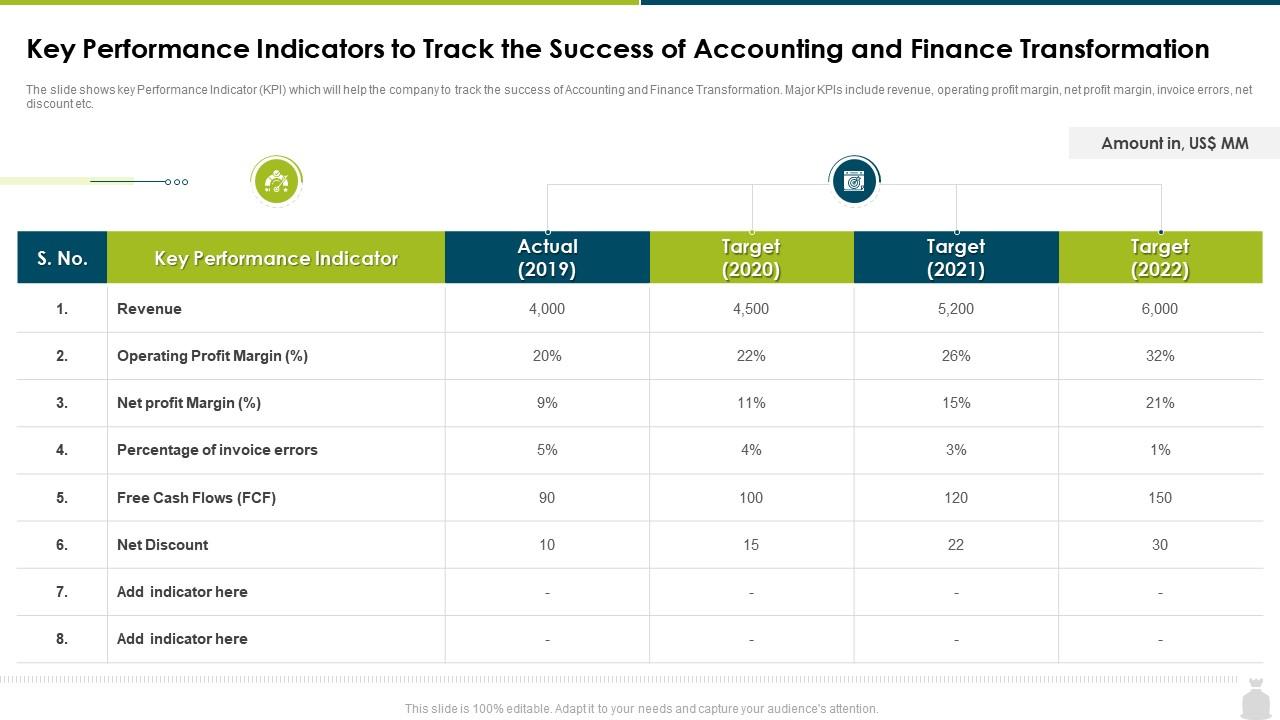
Evaluation and Adjustment
Regular assessment of KPIs on a quarterly basis.
Adjust strategies in real-time based on KPI performance.
Budget Estimation
Purpose
The budget estimation is crucial for allocating resources effectively across various activities outlined in the Plan. It ensures financial discipline and helps in tracking the return on investment.
Budget Components
Marketing: Allocation for advertising, promotions, and digital marketing campaigns.
Client Service: Resources for customer support, account management, and relationship building.
Product Development: Investment in research and development for new products and improvement of existing ones.
Other Efforts: Funds for training, technology upgrades, and miscellaneous activities.
Estimated Budget Table
Activity | Q1 Allocation | Q2 Allocation | Q3 Allocation | Q4 Allocation | Total Yearly Budget |
|---|---|---|---|---|---|
Marketing | $20,000 | $25,000 | $30,000 | $35,000 | $110,000 |
Client Service | [Amount] | [Amount] | [Amount] | [Amount] | [Amount] |
Product Development | [Amount] | [Amount] | [Amount] | [Amount] | [Amount] |
Other | [Amount] | [Amount] | [Amount] | [Amount] | [Amount] |
Total Budget | $50,000 | [Amount] | [Amount] | [Amount] | [Amount] |
Monitoring and Review
Continuous monitoring of budget utilization against the plan.
Quarterly financial reviews to adjust allocations as necessary.
This detailed KPI framework and budget estimation provide a robust structure for measuring the success of the Plan and ensuring effective allocation of financial resources. These tools will enable us to track progress, make informed decisions, and adjust our strategies for optimal results.
Review and Adjustments
Adaptive Strategy
The Annual Account Strategy Plan is not a static blueprint but a dynamic framework designed to respond to evolving market conditions and client needs. Recognizing that the business environment is in constant flux, regular reviews are essential to ensure the plan remains aligned with our objectives and external realities. This ongoing process involves evaluating the effectiveness of our strategies, measuring outcomes against our predetermined Key Performance Indicators (KPIs), and identifying areas where adjustments are necessary. This adaptability is not just about rectifying shortcomings but also about capitalizing on unforeseen opportunities that arise during the course of the year.
Continuous Improvement
Our approach to reviewing and adjusting the plan is rooted in a philosophy of continuous improvement. Quarterly reviews will be conducted to assess progress, with a particular focus on client feedback, market trends, and operational performance. These reviews will serve as checkpoints, where insights gained can be used to refine our strategies. This process will be underpinned by a commitment to learning - taking lessons from both our successes and our challenges. By fostering a culture that values feedback and agility, we ensure that our strategies stay relevant and effective, thereby safeguarding our competitive edge and the satisfaction of our clients.
Plan Conclusion
Fostering Client Relationships and Growth
The essence of the Annual Account Strategy Plan lies in its commitment to nurturing and enhancing client relationships. By placing our clients at the center of our strategies, we aim not only to meet but exceed their expectations, fostering loyalty and trust. This client-centric approach is pivotal in driving account growth and profitability. The plan, with its detailed objectives and strategies, serves as a roadmap for achieving sustained growth, reinforcing our market position, and creating value for both our clients and our organization.
Dynamic Approach for Long-Term Success
The dynamic nature of this plan is its most significant strength. It allows for flexibility and responsiveness to changing market trends and client preferences, which is crucial for long-term success in a rapidly evolving business landscape. By continually assessing our performance and making informed adjustments, we stay ahead of the curve, adapting to new challenges and seizing new opportunities. The plan is not just a guideline for the upcoming year but a foundation for long-term strategic planning, ensuring that our organization remains resilient, proactive, and forward-thinking.
- 100% Customizable, free editor
- Access 1 Million+ Templates, photo’s & graphics
- Download or share as a template
- Click and replace photos, graphics, text, backgrounds
- Resize, crop, AI write & more
- Access advanced editor
Presenting Template.net's Annual Account Strategy Plan Template, your gateway to strategic excellence! This adaptable document, customizable with our AI editor tool, empowers you to effortlessly create tailored account strategies. Achieve your annual goals with precision, boost profitability, enhance client relationships, and excel in your business endeavors. Elevate your strategy today with Template.net!
You may also like
- Finance Plan
- Construction Plan
- Sales Plan
- Development Plan
- Career Plan
- Budget Plan
- HR Plan
- Education Plan
- Transition Plan
- Work Plan
- Training Plan
- Communication Plan
- Operation Plan
- Health And Safety Plan
- Strategy Plan
- Professional Development Plan
- Advertising Plan
- Risk Management Plan
- Restaurant Plan
- School Plan
- Nursing Home Patient Care Plan
- Nursing Care Plan
- Plan Event
- Startup Plan
- Social Media Plan
- Staffing Plan
- Annual Plan
- Content Plan
- Payment Plan
- Implementation Plan
- Hotel Plan
- Workout Plan
- Accounting Plan
- Campaign Plan
- Essay Plan
- 30 60 90 Day Plan
- Research Plan
- Recruitment Plan
- 90 Day Plan
- Quarterly Plan
- Emergency Plan
- 5 Year Plan
- Gym Plan
- Personal Plan
- IT and Software Plan
- Treatment Plan
- Real Estate Plan
- Law Firm Plan
- Healthcare Plan
- Improvement Plan
- Media Plan
- 5 Year Business Plan
- Learning Plan
- Marketing Campaign Plan
- Travel Agency Plan
- Cleaning Services Plan
- Interior Design Plan
- Performance Plan
- PR Plan
- Birth Plan
- Life Plan
- SEO Plan
- Disaster Recovery Plan
- Continuity Plan
- Launch Plan
- Legal Plan
- Behavior Plan
- Performance Improvement Plan
- Salon Plan
- Security Plan
- Security Management Plan
- Employee Development Plan
- Quality Plan
- Service Improvement Plan
- Growth Plan
- Incident Response Plan
- Basketball Plan
- Emergency Action Plan
- Product Launch Plan
- Spa Plan
- Employee Training Plan
- Data Analysis Plan
- Employee Action Plan
- Territory Plan
- Audit Plan
- Classroom Plan
- Activity Plan
- Parenting Plan
- Care Plan
- Project Execution Plan
- Exercise Plan
- Internship Plan
- Software Development Plan
- Continuous Improvement Plan
- Leave Plan
- 90 Day Sales Plan
- Advertising Agency Plan
- Employee Transition Plan
- Smart Action Plan
- Workplace Safety Plan
- Behavior Change Plan
- Contingency Plan
- Continuity of Operations Plan
- Health Plan
- Quality Control Plan
- Self Plan
- Sports Development Plan
- Change Management Plan
- Ecommerce Plan
- Personal Financial Plan
- Process Improvement Plan
- 30-60-90 Day Sales Plan
- Crisis Management Plan
- Engagement Plan
- Execution Plan
- Pandemic Plan
- Quality Assurance Plan
- Service Continuity Plan
- Agile Project Plan
- Fundraising Plan
- Job Transition Plan
- Asset Maintenance Plan
- Maintenance Plan
- Software Test Plan
- Staff Training and Development Plan
- 3 Year Plan
- Brand Activation Plan
- Release Plan
- Resource Plan
- Risk Mitigation Plan
- Teacher Plan
- 30 60 90 Day Plan for New Manager
- Food Safety Plan
- Food Truck Plan
- Hiring Plan
- Quality Management Plan
- Wellness Plan
- Behavior Intervention Plan
- Bonus Plan
- Investment Plan
- Maternity Leave Plan
- Pandemic Response Plan
- Succession Planning
- Coaching Plan
- Configuration Management Plan
- Remote Work Plan
- Self Care Plan
- Teaching Plan
- 100-Day Plan
- HACCP Plan
- Student Plan
- Sustainability Plan
- 30 60 90 Day Plan for Interview
- Access Plan
- Site Specific Safety Plan




